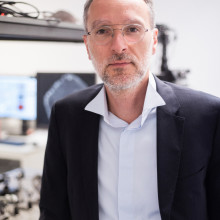Optical microscopy constitutes one of the most fundamental paradigms in biological and medical imaging. However, significant challenges remain in regard to the application of optical microscopy to in vivo interrogations. First, the diffusing nature of light propagation in tissue due to random variations of the refractive index, limits in vivo microscopy to superficial depths; within only a few mean free paths (<1mm). Second the invasive nature of fluorescent proteins and probes, allows monitoring of only 1-5 events by spectrally multiplexing different fluorochromes; i.e. performance that is highly incompatible with the targets of functional genomics and proteomics.
The new optical imaging ability delivered in DynAMic will be applied to a first target application of ophthalmic imaging, also used as a window to the brain and nervous disease detection, defining the next generation ophthalmology and neurology sensing of devastating diseases, disrupting the modus operandi of retinal and neuronal imaging without disturbing the modus agendi of the end users.
The long term vision and ambition of DynAMic is to revolutionize microscopic imaging by breaking i) the depth-to-resolution ratio and ii) the limited number of labels visualized, offering non-invasive, real time, high resolution, multiparametric in vivo imaging, across length scales, deep in biological complex media.
DynAMic proposes a radically new concept for optical imaging of tissue based on:
- Developing real-time wavefront-shaping adaptive optics for making the performance of any optical system ideal and for the first time in coherent Raman microscopy.
- Reaching tenfold deeper in tissue than conventional optical microscopy by compensating for the refractive index variations using phase and polarization retrieval for inversing light diffusion.
- Utilizing advance image formation to improve the sensitivity and utilization of stimulated Raman scattering for multi-parametric label-free contrast that radically expands at least tenfold the number of labels concurrently retrieved from living systems, linking optical observation to functional proteomic requirements.
Funding

To: 26/05/2021 14:00
Molecular-based approaches for understanding and tailoring structure-property-processing relations in materials, based on the fundamental principles of quantum and statistical mechanics, have gained ground in academic research and industrial practice. They have been greatly aided by an unprecedented growth in computer power, but also by new, efficient theoretical and computational methods and algorithms. The broad spectra of length and time scales governing structure and dynamics in real-life materials have demanded the advancement of multiscale modeling strategies, involving several levels of representation, to bridge atomistic constitution and interactions with macroscopic properties.
In this talk we will discuss three examples of molecular modeling of structure-property relations in polymeric materials: (a) prediction of linear and nonlinear rheological properties of polymer melts through hybrid particle-field mesoscopic simulations employing slip-springs to represent entanglements and parameterized on the basis of atomistic calculations; (b) tracking structural relaxation in polymer glasses as a sequence of elementary transitions between basins on their energy hypersurface, with transition rate constants computed from atomistic infrequent-event analysis; (c) quantifying the conditions for local interfacial failure in epoxy/graphene interfaces through stress-controlled nonequilibrium molecular dynamics simulations.
To: 12/05/2021 14:00
Metabolomics is the high-throughput quantitative analysis of the low molecular weight molecules in a biological system. Wrongly confused with chemometrics, as they use the same analytical set up, metabolomics is a multi-step biomolecular analysis aiming at providing a wide perspective of the metabolic physiology. Metabolism is the intertwined network of metabolic reaction pathways, which catabolize the carbon and energy resources of a system, to synthesize biomass for the system’s activity and growth and produce energy needed for all vital processes. Metabolomics quantifies the molecules that act as reactants and products in the metabolic reactions and as regulatory molecules of many proteins. It is thus the collective analysis of the measured abundances in the context of the role that these molecules play in the metabolic network in particular and in the overall biomolecular network at large, that can upgrade the information content of the metabolomic datasets. Molecular quantities being interconnected based on a certain stoichiometry, even subtle differences in one can carry significance if viewed in the context of the observed changes in the rest of the molecules. Moreover, one can explore disruptions in the network connectivity and dynamics to reveal molecular mechanisms of pathophysiologies and/or identify targets of systematic external intervention. Hence, metabolomics in systems biology can be a significant tool in many fields, from precision/translational medicine and personalized nutrition, to precision agriculture, ecology, functional genomics and synthetic biology.
In this seminar, I will use two recent collaborative studies of my group in quite distinct fields, translational psychiatry and ecophysiology, to support the power of metabolomics in systems biology to discriminate between physiologies with subtle differences when the conventionally applied tests and physiological measurements cannot, revealing characteristic multi-compound profiles that can form the basis for sensitive diagnostic tools, while providing clues for underlying molecular mechanisms and confounding factors that had been unknown so far. The importance of standardized experimental and computational protocols for designing and executing a reliable metabolomic study will also be discussed.
To: 21/04/2021 14:00
This talk concerns a computational study of polystyrene (PS) star-shaped polymers with a variety of functionalities (number of arms) through atomistic molecular dynamic simulations.
Our atomistic model captures chemical characteristics of polystyrene, allowing us to obtain quantitative information about the structural properties of the material that is not easily accessible by experiments or coarse-grained simulation models.
The analysis focuses on the intramolecular structure and the morphology of the material. The results are analyzed as a function of the star functionality. The obtained conformational characteristics are compared with well-known theoretical models. Additionally, we study quantitatively the internal impenetrable region of the stars via a novel geometric algorithm. The impenetrable region is also present in the systems such as soft colloids or hairy particles and is responsible for a complex dynamical behavior of the material. The aim of our study is to bridge the gap between the theoretical models and the experimentally observed phenomena of star-shaped polymers by providing an insight into the morphology of polystyrene stars at nanoscale.



